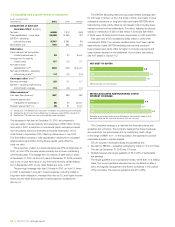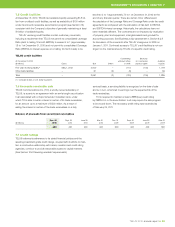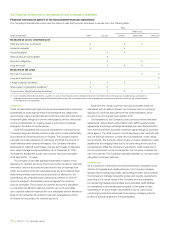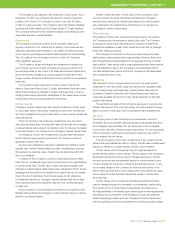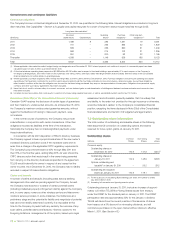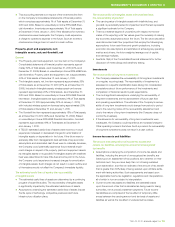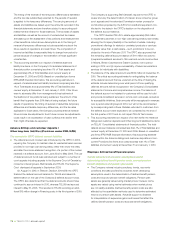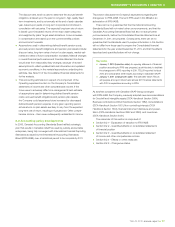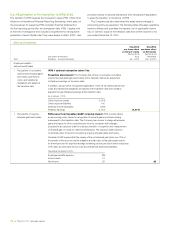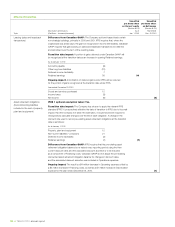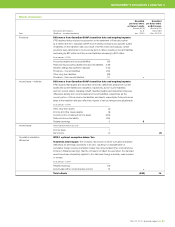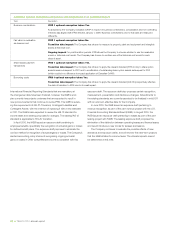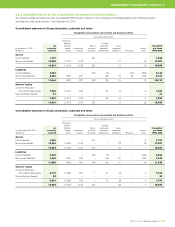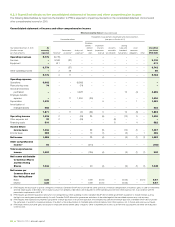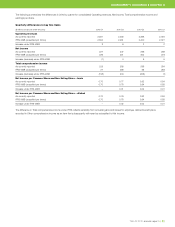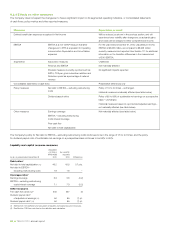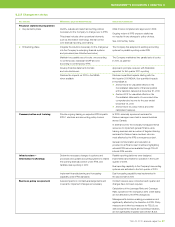Telus 2010 Annual Report Download - page 82
Download and view the complete annual report
Please find page 82 of the 2010 Telus annual report below. You can navigate through the pages in the report by either clicking on the pages listed below, or by using the keyword search tool below to find specific information within the annual report.
78 . TELUS 2010 annual report
Effects of transition
Topic
Unaudited Unaudited
pro forma effect pro forma effect
on Owners’ equity on Net income
(Section 8.2.2) (Section 8.2.3)
Description and impacts As at Year ended
($ millions – increase (decrease)) Jan. 1, 2010 Dec. 31, 2010
Employee benefits –
defined benefit plans
.Recognition of cumulative
unamortized actuarial gains
and losses, past service
costs, and transitional
obligations and assets at
the transition date
IFRS 1 optional exemption taken: Yes.
Transition date impact: The Company has chosen to recognize cumulative
unamortized actuarial gains and losses at the transition date as an adjustment
to Retained earnings on the same date.
In addition, as part of the retrospective application of IAS 19, all vested past service
costs and transitional obligations and assets at the transition date were similarly
adjusted through Retained earnings at the transition date.
As at January 1, 2010
Other long-term assets (1,314)
Other long-term liabilities 142
Deferred income tax liability (379)
Retained earnings (1,077) (1,077)
.Recognition of ongoing
actuarial gains and losses
Difference from Canadian GAAP; ongoing impact: IFRS currently allows
an accounting policy choice for recognition of actuarial gains and losses arising
subsequent to the transition date. The Company has chosen to charge all actuarial
gains and losses to Other comprehensive income, consistent with changes
proposed in an exposure draft for employee benefits – recognition and measurement
of actuarial gain or losses for defined benefit plans. The exposure draft proposes
to eliminate other choices for recognizing ongoing actuarial gains and losses.
Canadian GAAP required that the excess of the net actuarial gain (loss) over 10% of
the greater of the accrued benefit obligation and fair value of the plan assets was to
be amortized over the expected average remaining service periods of active employees
of the plan, as were past service costs and transitional assets and liabilities.
Year ended December 31, 2010
Employee benefits expense (39)
Income taxes 10
Net income 29 29
provides a series of optional exemptions from retrospective application
to ease the transition to the full set of IFRS.
The Company has also determined the areas where changes in
accounting policy are expected. The following table discusses qualitative
transition effects and quantifies the impacts, net of applicable income
tax, on Owners’ equity at the transition date and on Net income for the
year ended December 31, 2010.
8.2.1 Explanation of the transition to IFRS-IASB
The transition to IFRS requires the Company to apply IFRS 1 (First-Time
Adoption of International Financial Reporting Standards), which sets out
the procedures for preparing IFRS-compliant financial statements in
the first reporting period after the changeover date. IFRS 1 applies only
at the time of changeover and includes a requirement for retrospective
application of each standard as if they were always in effect. IFRS 1 also


